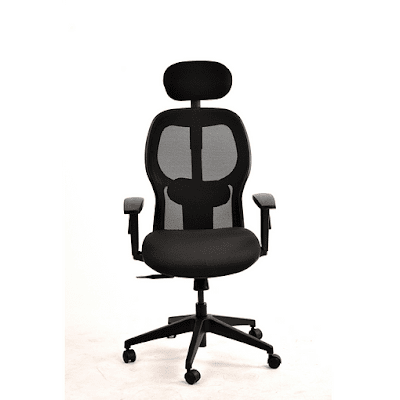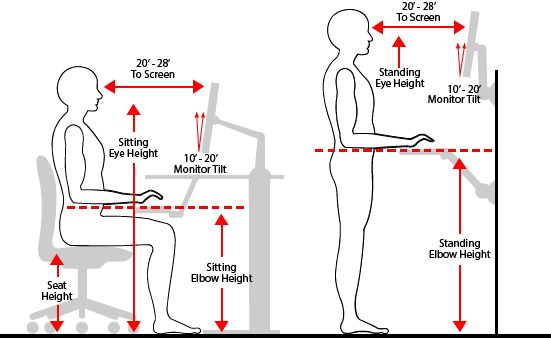9 Workplace Ergonomic Solutions for Your Office Chair and Work Station!
As a desk worker, you should focus on protecting your back
at all times. If you are not looking after your back properly and the
supporting structures of the lower body, then this could lead to health issues
that manifest themselves in other parts of the body such as pain and discomfort
in the neck or damaged joints in your cervical vertebrae.
As technology advances, it becomes much simpler to build a
deck that's ergonomic. Use these 9 tips pertaining to health and wellness to
ensure that the computer workstation you wear for hours in a day doesn't
negatively affect your overall well-being:
1. Place your upper arms parallel to your spine
When you sit at your desk, your upper arms must be
comfortably placed parallel to your spine and not protruding from the surface
of your desk. Your forearms and hands should be rested on the work surface such
that the underside of your forearm is touching the desktop or table. The
topside of your wrists should slightly extend off the edge of the surface as
well as a couple inches forward from it. If this seems unnatural for you,
adjust your office chair higher or lower, as necessary.
Placing your arms any place other than where they are meant
to be can give you a severe case of pain in the shoulder area and upper back.
2. Raise your chair to support your sit-to-stand movement
If your seat is positioned down too low, you'll be
effectively putting additional stress on your lower body while trying to get
up. This will ultimately lead to increased wear and tear on your joints, particularly
the hips and knee areas. Prolonged use of this type of seating will likely
result in recurrent stresses and pains in these joints.
A proper seat height allows us to sit comfortably with both
feet on the ground, knees bent and hips at 90-degree angles.
3. Boost your feet for support
Sometimes your desk or chair may be too high. This can lead
to you sitting uncomfortably all day long, leading to a lot of pain in the long
term. An easy way to avoid getting shoulder and back pain from spending too much
time working on your feet is by using a footstool.
Using a footstool
will ease tension in your legs and allow you to sit still for longer periods of
time, which ultimately increases productivity by reducing foot pain at the end
of the day.
4. Adjust your work surface to match your height
If you are tall and your shoulders tend to hunch over,
consider raising the height of your workstation or desk. Raising the height of
your desk will allow you to raise the armrest of your chair or desk on top so you
can be more comfortable in an at-ease posture when sitting for a long time.
This is a great way to help prevent pain in the neck, shoulder, back, and/or
spine.
5. Measure the depth of your seat
Your seat depth could be causing your back pain! If you
don't have the correct seat depth for your own body there are a few potential
fixes. The correct seat depth means that when you sit on the edge of it with
both feet on the floor and straighten out your legs, your knees shouldn't point
toward the underside of your desk.
To check the length of your desk chair, first sit down in it
by reclining all the way back. Next, simply measure the distance between the
front edge of your chair and your calves by making a fist and placing it on top
of your calf muscles. If you can fit your full fist between the front of your
chair and calf muscles or if your fist cannot yet reach that far when you are
fully seated, congratulations - this is likely a wise choice for you
considering that having enough legroom makes for healthier blood circulation!
6. Adjust your chair’s swivel and back support
Your work chair should provide back support by angling up to
or just past 90°. Some chairs may have excessive swivel and recline options,
which can be locked to prevent the chair from tipping back and forth.
Some Ergonomic
chairs, in particular ones with back support for the lower back, for
example, an adjustable lumbar band that can be moved up or down to fit right
into the small of one's back, offer increased lower back support.
7. Re-evaluate your sitting posture
Make a conscious effort to keep your bottom pressing up
against the back of your chair, and avoid slumping or slouching which can put a
strain on your lower back. It is important that you maintain an ergonomically
supported posture both when seated, and also when standing as this will help
protect against spinal damage and impurities.
To ensure that your
posture is well supported while you sit, aim to take a break and move around or
walk a short distance every 30 minutes to an hour. Elevate your gaze once you
are back at the computer for this time frame as it will help to improve eyesight.
8. Watch the height of your screen
Once your chair has been adjusted to the height of the
table, your feet have gotten good traction on the floor and your back is
supported, close your eyes and take a deep breath.
Sit straight up and forward with your nose in the middle of
your computer. Then blink twice until everything comes into view. If you think
you need to move the screen away from your face, you can place books or a
shoebox underneath it to get the right height.
9. Adjust your armrest to support your shoulders
Armrests play an important role. They can help you relieve
neck and shoulder strain, assisting the likelihood of slouching forward in your
chair. Adjusting your chair’s armrest to the point where your arms are slightly
lifted at the shoulders will allow them to support only the elbow and take some
weight off the shoulders.
Make these ergonomic adjustments today to help relieve
unwanted stress on your body. You can do this by synchronizing the position of
your workstation, office chair and having a better posture. If you find
yourself in the market to Buy Ergonomic
office chairs online, use the above tips to carefully study how its height,
width, and depth works for you, as well as how you can adjust it for your
armrests, backrest, and lumbar support.





A good ergonomic office chair reduces chronic back, hip and leg strain associated with being seated for long periods of time. you need to invest in a good ergonomic office chair as it will not only help in improving posture but also reduce back pain. An excellent office chair will adjust to your specific needs. Always choose your office chair based on your needs and comfort. Best quality office chairs can help to increase the daily productivity of the office.
ReplyDelete